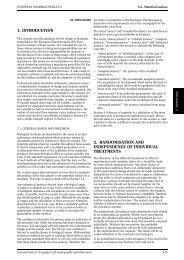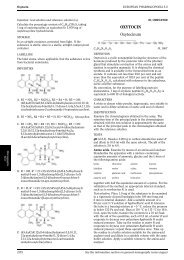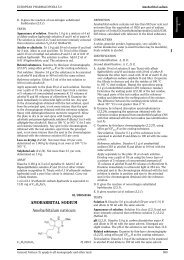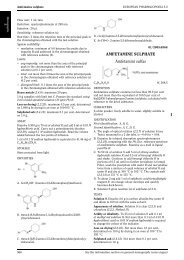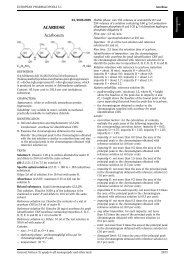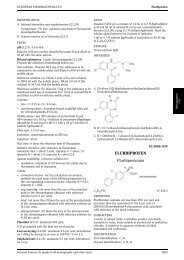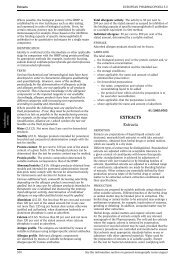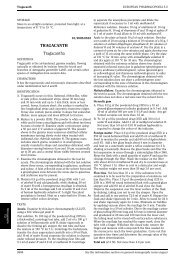EUGENOL Eugenolum
EUGENOL Eugenolum
EUGENOL Eugenolum
Create successful ePaper yourself
Turn your PDF publications into a flip-book with our unique Google optimized e-Paper software.
EUROPEAN PHARMACOPOEIA 5.0 Eugenol<br />
— helium for chromatography R as the carrier gas at a flow<br />
rate of 1.5 ml/min,<br />
— a flame-ionisation detector,<br />
— a split ratio of 1:100,<br />
maintaining the temperature of the column at 60 °C for<br />
5 min, then raising the temperature at a rate of 5 °C/min to<br />
200 °C and maintaining at 200 °C for 5 min; maintaining<br />
the temperature of the injection port and that of the detector<br />
at 220 °C.<br />
Inject about 0.5 µl of the reference solution. When the<br />
chromatogram is recorded in the prescribed conditions the<br />
components elute in the order indicated in the composition<br />
of the reference solution. Record the retention times of<br />
these substances.<br />
Theassayisnotvalidunless:thenumberoftheoretical<br />
plates calculated for the peak due to limonene at 110 °C<br />
is at least 30 000; the resolution between the peaks<br />
corresponding to limonene and cineole is at least 1.5.<br />
Inject about 0.5 µl of the test solution. Using the<br />
retention times determined from the chromatogram obtained<br />
with the reference solution, locate the components of the<br />
referencesolutiononthechromatogramobtainedwiththe<br />
test solution.<br />
Determine the percentage content of these components by<br />
the normalisation procedure.<br />
The percentages are within the following ranges:<br />
— α-pinene: tracesto9.0percent,<br />
— β-pinene: less than 1.5 per cent,<br />
— α-phellandrene: less than 1.5 per cent,<br />
— limonene: tracesto12.0percent,<br />
— 1,8-cineole: minimum 70.0 per cent,<br />
— camphor: less than 0.1 per cent.<br />
STORAGE<br />
In a well-filled, airtight container, protected from light and<br />
at a temperature not exceeding 25 °C.<br />
<strong>EUGENOL</strong><br />
<strong>Eugenolum</strong><br />
01/2005:1100<br />
C10H12O2 Mr 164.2<br />
DEFINITION<br />
Eugenol is 2-methoxy-4-(prop-2-enyl)phenol.<br />
CHARACTERS<br />
A colourless or pale yellow, clear liquid, darkening on<br />
exposure to air, with a strong odour of clove, practically<br />
insoluble in water, freely soluble in alcohol (70 per cent V/V),<br />
practically insoluble in glycerol, miscible with glacial acetic<br />
acid, with alcohol, with fatty oils and with methylene<br />
chloride.<br />
IDENTIFICATION<br />
First identification: B.<br />
Second identification: A, C, D.<br />
A. It complies with the test for refractive index (see Tests).<br />
B. Examine by infrared absorption spectrophotometry<br />
(2.2.24), comparing with the spectrum obtained with<br />
eugenol CRS.<br />
C. Examinebythin-layerchromatography(2.2.27), using a<br />
TLC silica gel F254 plate R.<br />
Test solution. Dissolve 50 µl of the substance to be<br />
examined in alcohol R and dilute to 25 ml with the same<br />
solvent.<br />
Reference solution. Dissolve 50 µl of eugenol CRS in<br />
alcohol R and dilute to 25 ml with the same solvent.<br />
Apply to the plate 5 µl of each solution. Develop over a<br />
path of 15 cm using a mixture of 10 volumes of ethyl<br />
acetate R and 90 volumes of toluene R. Drytheplatein<br />
a current of cold air and examine in ultraviolet light at<br />
254 nm. The principal spot in the chromatogram obtained<br />
with the test solution is similar in position and size to the<br />
principal spot in the chromatogram obtained with the<br />
reference solution. Spray with anisaldehyde solution R.<br />
Heat at 100-105 °C for 10 min. The principal spot in the<br />
chromatogram obtained with the test solution is similar<br />
in position, colour and size to the principal spot in the<br />
chromatogram obtained with the reference solution.<br />
D. Dissolve 0.05 ml in 2 ml of alcohol R and add 0.1 ml<br />
of ferric chloride solution R1. A dark green colour is<br />
produced which changes to yellowish-green within 10 min.<br />
TESTS<br />
Relative density (2.2.5): 1.066 to 1.070.<br />
Refractive index (2.2.6): 1.540 to 1.542.<br />
Dimeric and oligomeric compounds. Dissolve 0.150 g of<br />
the substance to be examined in ethanol R and dilute to<br />
100.0 ml with the same solvent. The absorbance of the<br />
solution (2.2.25) at 330 nm is not greater than 0.25.<br />
Related substances. Examine by gas chromatography<br />
(2.2.28).<br />
Test solution. Dissolve 1.00 g of the substance to be<br />
examined in ethanol R and dilute to 5.0 ml with the same<br />
solvent.<br />
Reference solution (a). Dilute1.0mlofthetestsolutionto<br />
100.0 ml with ethanol R.<br />
Reference solution (b). Dissolve50mgofvanillin R in 1 ml<br />
of the test solution and dilute to 5 ml with ethanol R.<br />
The chromatographic procedure may be carried out using:<br />
— a fused-silica capillary column 30 m long and<br />
0.25 mm in internal diameter coated with a film of<br />
polymethylphenylsiloxane R (film thickness 0.25 µm),<br />
— helium for chromatography R as the carrier gas at a flow<br />
rate of 1 ml/min,<br />
— a flame-ionisation detector,<br />
— a split ratio of 1:40,<br />
Time<br />
(min)<br />
Temperature<br />
(°C)<br />
Rate<br />
(°C/min)<br />
Comment<br />
Column 0-2 80 isothermal<br />
2-27 80→280 8 linear gradient<br />
27 - 47 280 isothermal<br />
Injection port 250<br />
Detector 280<br />
Inject 1 µl of the test solution and 1 µl each of reference<br />
solutions (a) and (b). The test is not valid unless in the<br />
chromatogram obtained with reference solution (b), the<br />
relative retention time of the peak due to vanillin is at least<br />
1.1 with respect to the peak due to eugenol. Calculate the<br />
percentage content of related substances from the areas<br />
GeneralNotices(1)applytoallmonographsandothertexts 1571
Eugenol EUROPEAN PHARMACOPOEIA 5.0<br />
of the peaks in the chromatogram obtained with the test<br />
solution by the normalisation procedure; disregard the<br />
solvent peak and any peak with an area less than 0.05 times<br />
that of the principal peak in the chromatogram obtained<br />
with reference solution (a). The content of related substances<br />
with a relative retention time greater than 2.0 in respect to<br />
themainpeakisnotgreaterthan1.0percent;thecontent<br />
of any related substances is not greater than 0.5 per cent;<br />
the total content of related substances is not greater than<br />
3.0 per cent.<br />
Hydrocarbons. Dissolve 1 ml in 5 ml of dilute sodium<br />
hydroxide solution R and add 30 ml of water R in a<br />
stoppered test-tube. Examined immediately, the solution is<br />
yellow and clear (2.2.1).<br />
Sulphated ash (2.4.14). Not more than 0.1 per cent,<br />
determined on 1.0 g.<br />
STORAGE<br />
Store in a well-filled container, protected from light.<br />
IMPURITIES<br />
A. (1R,4E,9S)-4,11,11-trimethyl-8-methylenebicyclo[7.2.0]undec-4-ene<br />
(β-caryophyllene),<br />
B. (1E,4E,8E)-2,6,6,9-tetramethylcycloundeca-1,4,8-triene<br />
(α-humulene, α-caryophyllene),<br />
C. (1R,4R,6R,10S)-4,12,12-trimethyl-9-methylene-5oxatricyclo[8.2.0.0<br />
4,6 ]dodecane (β-caryophyllene oxide),<br />
D.R1=H,R2=H,R3=CH 2-CH=CH 2: 4-(prop-2-enyl)phenol,<br />
E. R1 = CH 3,R2=OCH 3,R3=CH 2-CH=CH 2:<br />
1,2-dimethoxy-4-(prop-2-enyl)benzene (eugenol methyl<br />
ether),<br />
F. R1=H,R2=OCH 3,R3=CH=CH-CH 3 (cis):<br />
2-methoxy-4-[(Z)-prop-1-enyl]phenol (cis-isoeugenol),<br />
G.R1=H,R2=OCH 3,R3=CH=CH-CH 3 (trans):<br />
2-methoxy-4-[(E)-prop-1-enyl]phenol (trans-isoeugenol),<br />
H.R1=H,R2=OCH 3, R3 = CHO: 4-hydroxy-3methoxybenzaldehyde<br />
(vanillin),<br />
I. R1=CO-CH 3,R2=OCH 3,R3=CH 2-CH=CH 2:<br />
2-methoxy-4-(prop-2-enyl)phenyl acetate (acetyleugenol),<br />
J. R1=H,R2=OCH 3,R3=CO-CH=CH 2:<br />
1-(4-hydroxy-3-methoxyphenyl)prop-2-enone,<br />
K.R1=H,R2=OCH 3, R3 = CH=CH-CHO:<br />
(E)-3-(4-hydroxy-3-methoxyphenyl)prop-2-enal<br />
(trans-coniferyl aldehyde),<br />
L. 2-methoxy-4-[3-methyl-5-(prop-2-enyl)-2,3dihydrobenzofuran-2-yl]phenol<br />
(dehydrodi-isoeugenol),<br />
M. 3,3′-dimethoxy-5,5′-bis(prop-2-enyl)biphenyl-2,2′-diol<br />
(dehydrodieugenol),<br />
N. O. two further unknown dimeric compounds,<br />
P. toluene.<br />
1572 See the information section on general monographs (cover pages)



